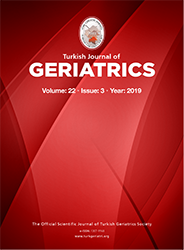2Ege University Faculty of Science, Department of Statistics, Bornova/Ä°zmir, Turkey DOI : 10.31086/tjgeri.2019.102 Introduction: Idiopathic facial paralysis or Bell's palsy is the most common type of peripheral facial paralysis. Advanced age and systemic diseases, such as diabetes and hypertension are considered as negative prognostic factors for Bell's palsy still controversial. Here, we aimed to compare the epidemiologic features and prognostic factors of patients with Bell's palsy aged ≥65 years.
Materials and Method: Records of patients with Bell's palsy (age, ≥65 years) who were admitted to our clinic between January 2008 and December 2017 were evaluated.
Results: We included 89 (72.4%) patients with Bell's palsy. The patients" ages varied between 65 and 91 (72.70 ± 5.9) years. Paralysis was in the right side in 59.6% (n = 53) and in the left side in 40.4% (n = 36) of the patients. Three (3.4%) patients had progressive facial paralysis. One (1.1%) had positive family history. After at least 6 months of follow-up, 71 (79.8%), 10 (11.2%), 6 (6.7%), and 2 (2.25%) patients were diagnosed with grade 1 and 2, 3, 4, and 5 Bell's palsy, respectively. Furthermore, a statistically significant correlation was observed between the initial paralysis grade and neutrophil-to-lymphocyte ratio (p=0.001).
Conclusion: Although old age is considered as a negative prognostic factor in patients with BP, we observed satisfactory recovery rates in geriatric patients who received appropriate treatment. In addition, a significant correlation was observed between the initial grade of facial paralysis and neutrophil-to-lymphocyte ratio upon admission, which can be considered as a prognostic factor.
Keywords : Bell palsy; Geriatrics; Inflammation; Neutrophils; Blood platelets; Prognosis
